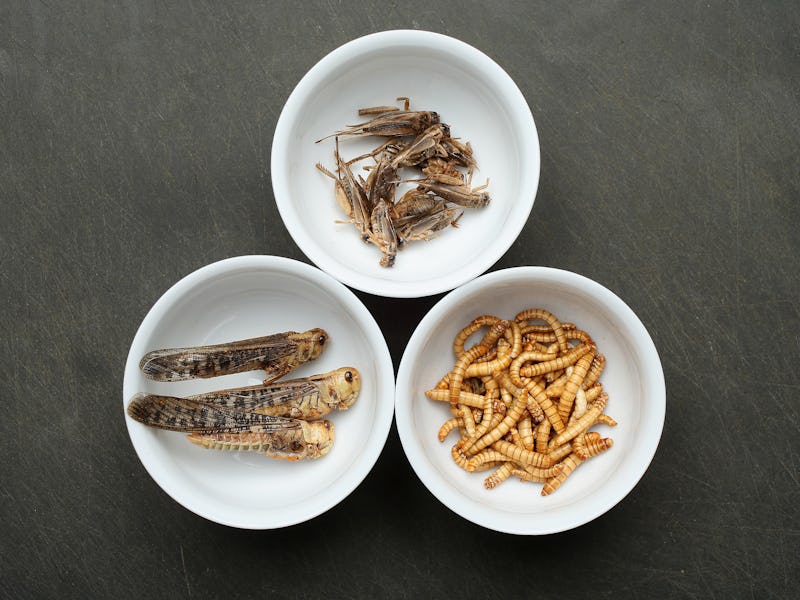Can Saving the Planet Become a Workout Fad?
Promoting bug consumption is about targeting a demographic. But CrossFit hasn't birthed an environmental movement just yet.

Greg Sewitz, co-founder of the protein bar company Exo, wants to know if I’ve heard of CrossFit. He’s not asking because he wants to flip tires or get Rhabdomyolysis; he’s asking because he thinks the CrossFit people are his company’s natural demographic. He thinks the emerging athletic middle class, currently decked out in Impact font, will buy his heavily branded T-shirts once they get pumped about eating bars made of roughly 40 crickets a piece.
The promotional literature for Exo (gluten-free! soy-free! dairy-free! preservative-free!) comes with endorsements and partnerships from Michelin-starred chefs, triathletes, authors of books about trendy diets, and the rapper Nas, who is an investor. The origin story checks all the major boxes: dorm-room startup, core idea that is easy for enough customers and investors to embrace but still controversial enough to be framed as visionary, sleeper-hit Kickstarter campaign. The bars have been favorably reviewed by pretty much every major media outlet since Exo began selling them in March 2014. If a cricket flour product is going to take off in the near future, it’s likely going to be this one. But Exo isn’t PowerBar just yet.
Each bar contains 10 grams of protein derived from cricket flour.
The two most popular arguments for eating bugs are almost always that they are 1) extremely cost-effective and 2) an excellent, nutrient-dense source of protein.
That said, the third argument is probably the most compelling: cricket farming is imminently more sustainable than cattle farming, which produces 100 times the greenhouse gas and requires 22,000 times the water necessary to get an equivalent amount of product. The general idea, then, is that eating crickets and other bugs helps mitigate a number of massive problems — climate change, malnutrition (in terms of nutrients), and hunger (in terms of poverty), just for starters.
But all those benefits come at a cost money and taste. At $2.99 per bar — on Exo’s website, where the company does most of its sales, you can buy a sample pack of five for $15 or 12 of any flavor for $36 — these bugs aren’t especially cheap. Exo bars come in five flavors: Peanut Butter and Jelly, Blueberry Vanilla, Apple Cinnamon, Cocoa Nut, and Banana Bread, which range in taste from okay to slightly less than okay. Each flavor contains 10 grams of protein, 23 to 30 grams of carbs, five to seven grams of fiber, and 260 to 300 calories.
How, then, can Exo bars hope to compete with other foods marketed for their protein — say, greek yogurt, a product which has twice the protein, half the calories and a third of the carbs, is cheaper, and doesn’t mostly gross people out?
“At this stage, we’re mostly targeting early adopters of health and wellness [trends],” Sewitz said. “Fitness people who are pretty well-informed about their diet and the latest in food nutrition.”
The CrossFit people matter, in short, because they care more about the nutritional value of the bars, may prove immune to the ick factor, and are invariably hungry for the next thing regardless of whether or not that thing has a carapace. Arguably they’ve already shown them to be open to unusual eating experiences. Quest protein bars, for instance, offer consumers the sensation of eating a chewy brick. Exo bars feel more organic because they stand out from comparable options like beef jerky, which offers lots of protein and little else. Exo bars give a more complete nutrient profile, in a Soylent kind of way. Bug products tend to be rich in amino acids and proteins; the Exo bar crickets will serve you with more than twice the amount of iron you’d get from an equivalent serving of spinach.
This is why purveyors of cricket flour don’t worry too much about taste. If you get that far, you’re probably already the kind of person who’s fine with it. That’s doubly true given that the bars are expensive. It’s a boutique product for a specific audience. Cricket product are arguably already there, but trendiness has not ensued. The mass market remains hard to reach even though, in a sense, Exo is similar to Sweetgreen, an expensive, healthy product in its infancy. Maybe bug snacks have to become more artisanal and indulgent before becoming more mass market. Exo may, for the moment, exist in an uncomfortable middle ground.
Exo is working on new flavors and new product lines for 2017. Everything will still be cricket-based; Sewitz said the early informal research they conducted suggested that, as bugs go, people reacted most positively to crickets (as opposed to mealworms). People remain more compelled by the idea of doing pull-ups while being yelled at by a handsome professional, but the one thing may lead into the other. And if it does, the world will get healthier.